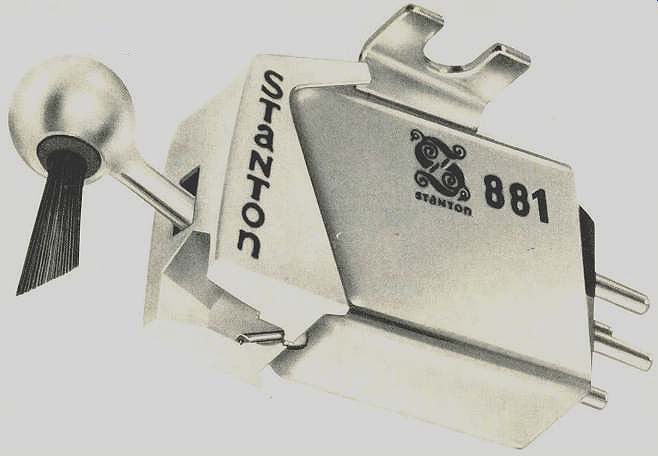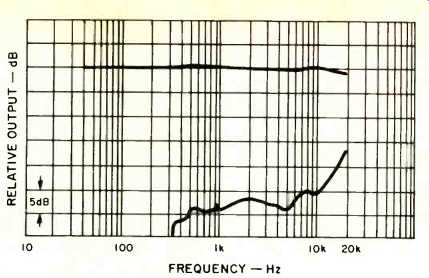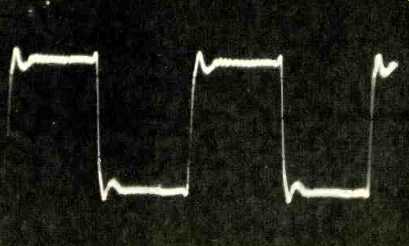
MANUFACTURER'S SPECIFICATIONS:
Stylus Description: Nude Stereohedron.
Tracking Force: 3/4, to 1 1/4 grams.
Frequency Response: 10 Hz to 20 kHz, ±1.5 dB.
Output: 1.01 mV/cm/sec.
Channel Separation: 35 dB at 1 kHz.
Inductance: 518 mH, each channel.
Resistance, Each Channel: 889 ohms.
Load Resistance: 47 kilohms.
Load Capacitance: 275 pF.
Replacement Stylus: D81.
Accessory Stylus for Mono LP Records: D810.
Accessory Stylus for 78-rpm Records: D827.
Price: $150.00, with "longhair" brush attached.
----- ---------
Stanton Magnetics introduced the first American-made CD-4 cartridge, which was capable of reproducing frequencies up to 30 kHz with their now historical Quadrahedral® stylus. Continued research and development brought about the new stereo stylus shape, Stereohedron®, which has its roots in the CD-4 Quadrahedron stylus design. The Stereohedron stylus offers a greater contact area with the record groove, resulting in less groove wear. This stylus development is included in Stanton's new generation of cartridges whose much smaller than usual magnet is made of samarium-cobalt and positioned closer to the center of rotation for low inertia, using a newly patented suspension principle. Its cantilever is strong enough to withstand repeated rough skating across a record surface without damage, though we don't recommend the procedure. Another little known but important feature of the Stanton cartridges is that hardly any dust collects on the stylus or cantilever because the cantilever is grounded. Like all Stanton cartridges, a re movable longhair dust brush is mounted on the front which is said to add some stabilization to the cartridge in fighting warps.
Measurements
As is our practice, measurements are made on both channels, but only the left channel is reported. During the test period the average temperature was 74° F ±1° (23.3° C) and the relative humidity 58 percent, ± 3 percent.
Frequency response using the Columbia STR-100 test record and our reference tone arm, an Audio-Technica AT 1009, mounted on a Technics SP-10 turntable, is flat within 0.5 dB from 40 Hz to 5 kHz, down almost 1 dB from 5 to 6 kHz, rises slowly to 0 dB at 9 to 13.5 kHz, and then slowly descends to -1.5 dB at 20 kHz. The optimum tracking force for the cartridge we tested was greater than the maximum tracking recommended. We found it necessary to increase the maximum tracking force by another 250 mg with the brush removed for a total of 1.5 grams if we were to track, without distortion, some of the very high recorded velocities that are present on some direct-to-disc records. However, we must state that the 881S successfully tracked some classical and jazz recordings at just 0.6 grams tracking force without distortion. This is absolutely remarkable since it is a rare cartridge that can track below 0.75 grams without distorting on this type of recording. The optimum anti-skating force was 1.5 grams. Separation was excellent, being 29 dB at 1 kHz, 26 dB at 10 kHz, and 17.5 dB at 20 kHz. The load resistance and capacitance, respectively, were 47,000 ohms and 280 pF.
Square waves show some ringing that dies rapidly, indicating that the resonances are well damped, wit, the peak well beyond 20 kHz.
To check the frequency response, we used the General Radio 1521-B Graphic Level Recorder and a relatively new United Recording Electronics Industries (UREI) 4odel 200 X-Y plotter with the Model 2010 plug-in module for frequency response with any sweep-frequency test record. This is an improvement on other graphic level recorders since they are generally limited to a special sweep-frequency test record (s) made for them. The frequency response plotted on the UREI X-Y recorder was identical to that plotted on the G. feral Radio recorder, using the same test record. One great advantage of the UREI X-Y recorder is its ability to pick up and automatically record the recorded spot frequencies on a test record without regard to the voice announcing the frequencies. In many ways, this is the more accurate way to test cartridge frequency response than the usual recorded sweep frequencies and just as automatic.
The following test records were used in making the following reported measurements:
Technics SFC-TR100; Micro Acoustics TT2002; Shure TTR 103, TTR 109, TTR 110, TTR 115; Columbia STR-100, STR-112, SQT-1100; JVC TRS-1007; Stereo Review SR-12; B & K QR-2009; Deutsches HiFi No. 2, and Nippon Columbia Audio Technical Records (PCM) XL-7004 6.
The cartridge weighs 5.19 gm without brush; d.c. res. 830 ohms; ind. 527 mH; opt. tracking force 1.5 gm; opt. anti-skating force 1.5 gm; output 1.36 mV/cm/sec; IM dist. (4:1) + 9 dB lateral, 200/4000 2.7 percent, +6 dB vertical, 200/4000 6.1 percent; crosstalk- 35 dB (Shure TTR 109); ch. bal. 1 dB; trackability, high freq. (10.8 kHz pulsed) 30 cm/sec, mid-freq. (1000 + 1500 Hz lat. cut) 31.5 cm/sec, low freq. (400 + 4000 Hz lat. cut) 24 cm/sec; Deutsches HiFi No. 2 300 Hz test bands tracked to 95 microns (0.0095 cm) and lateral to 55.4 microns (0.00554 cm) vertical. Arm-cartridge resonance curve was double peaked with the first resonant peak being +1 dB at 6 Hz and the second as +2.5 dB at 7.5 Hz.

Fig. 1--Frequency response.

Fig. 2--Response to 1-kHz square wave.
The Micro-Acoustics Transient and Tracking Ability Test Record TT-2002 was used to check for tracking ability first and then transient ability. The Stanton 881S cartridge had no difficulty in playing all tracking-ability bands, including one with the highest level a modern stereo cutter head can record just prior to tripping its overload protection circuit. The stereo percussion levels check the cartridge for both vertical and lateral tracking ability. The transient ability of the 881S is excellent. The computer-generated high, low, and the high/ low mixed frequencies presented no problems to this cartridge.
The 881S performed excellently on all bands of the Shure Audio Obstacle Course- Era Ill (TTR-110). With the newer Shure Audio Obstacle Course- Era IV (TTR-115) the trackability of the 881S on the bells and flute individually was just shy of reproducing the very highest level cleanly. However, the cartridge had no difficulty in reproducing the highest level of the same flute and bells playing a duet. These results clearly point out the excellence of the tracking ability of the Stanton 881S phono cartridge.
Listening and Use Tests
Our listening tests are performed both prior to actually testing the cartridge parameters and after all tests have been completed. While listening to the various records played with the Stanton 881S cartridge, we were quite impressed with the excellent sonic clarity, bass response, and the transient and tracking ability of this cartridge, particularly on some of the direct-to-disc recordings with their very high levels. Continued listening brought out the fact that the Stanton 881S did not introduce any sound or coloration that could be ascribed to the cartridge, per se. In general, we found that the listening tests were in agreement with the various measurement tests.
The following equipment was used for the listening evaluation: Technics SP-10 turntable with Audio-Technica AT-1009 tonearm, Technics SP-10 Mark II turntable with EPA-100 tonearm, Crown IC-150A preamplifiers, a pair of Crown DC-300A amplifiers used as monophonic amplifiers, and a pair of stacked Duntech DL-15B speakers for each channel. One turntable was equipped with a Platter Pad (Dundis Distr. Co., Waterloo, Neb. 68069) which appeared to be an improvement over the usual rubber pad, particularly in damping out extraneous vibrations. The speakers were connected to the amplifiers with Polk Audio high-definition, low-distortion speaker cables, which appear to have improved bass definition and high-end detail and smoothness. The SQ quadraphonic decoder was the Columbia SQL-400A Full Logic Decoder and Stereo Enhancer.
As is our practice, a rigorous listening evaluation was con ducted utilizing the specific records listed below as well as some of the records listed in our past reviews. These excellent recordings demonstrate very effectively the ability of the Stanton 881S cartridge to reproduce difficult high level recordings faithfully. All records were cleaned with the Discwasher and de-staticized with the Zerostat. The SQ records listed are compatible and can be played as stereo records.
Stereo
Pops Concert, the Israel Philharmonic Orchestra, Mehta--London CS 7065.
Vladimir Ashkenazy: The Piano Music of Chopin, Volume 3--London CS 7030.
The Art of Regina Resnik--London OS 26574.
Organ Recital, Volumes 1 & 2, Earl Barr--The Sound Environment TR-1003 and TR-1006. ( Suite 114, Butler Sq., 100 North 6th St., Minneapolis, Minn. 55403).
Zgodava Plays Recital Favorites--The Sound Environment TR-1001. (Note the great clarity and brilliance of the nine-foot Steinway on Side 1. A seven-foot Steinway was used on Side 2. These exceptionally good recordings were recorded by Russell Borud of St. Paul, Minnesota).
Rogers and Hammerstein: The King and I--RCA ABL 1-2610.
Check Up Your Sounds, Volume 2, Audio Symphony No. 2, NHK Symphony Orchestra, K. Komatsu--RCA ( Japan) RVL-2. Distributed by Audio-Technica, Inc. (This is a superb recording that all audiophiles should hear and own.)
Direct to Disc
Rimsky-Korsakov & Tchaikovsky: Capriccio espagnol & Capriccio italien, the Boston Pops, Fiedler--Crystal Clear Records CCS-7003 ( 225 Kearney St., San Francisco, Calif. 94108).
Virgil Fox: The Fox Touch, Volumes 1 & 2--Crystal Clear Records CCS-7001 and 7002. (Audio's Associate Editor, Bert Whyte, was the recording engineer for the above three super records).
Joe Marcinkiewicz and Blu--M&K Sound, Inc. 10014. ( 8719 Wilshire Blvd., Beverly Hills, California 90211).
Rough Trade: Live!--Umbrella UMB-DD1, Distributed by Audio-Technica, Inc.
The New Brubeck Quartet: A Cut Above!--Direct-Disk DD 106. (Direct-Disc, 16 Music Circle So., Nashville, Tenn. 37203) .
Power--Direct-Disk Labs, DD-107.
Pulse Code Modulation [PCM, Digital]
Frank Foster and the Loud Minority: Manhattan Fever--Denon YX-7521-ND.
Tommy Flanagan: Alone Too Long--Denon YX-7523-ND. (Solo piano.)
Archie Shepp: On Green Dolphin Street--Denon YX-2524 ND.
(Denon records are available through local outlets from American Audioport, 1407 No. Providence Rd., Columbia, Mo. 65201).
Quadraphonic
Stokowski Conducts Sibelius, The National Philharmonic Orchestra-- Columbia M34548.
Preservation Hall Jazz Band--Columbia M34549.
Boulez Conducts Varése, New York Philharmonic Orchestra--Columbia M34552.
The Stanton 881S played all the above records without difficulty, particularly The Fox Touch, Volume 2, and the Boston Pops recording of Capriccio espagnol, with their high level bass. It appears that most all direct-to-disc recordings are challenging the modern cartridge to reproduce the music with sonic clarity.
In conclusion, we are impressed with the Stanton 881S cartridge, particularly with its ability to reproduce flawlessly any recorded sound, including those at the high velocities present on many current records. The Stanton 881S merits serious consideration by all music lovers.
------ B. V. Pisha
(Source: Audio magazine, Nov. 1978)
Also see:
Stanton 980LZS Phono Cartridge (Feb. 1982)
Stanton Permostat Anti-Static Record Treatment (May 1979)
Stanton Magnetics (ad, Nov. 1978)
Technics SP-10MK3 Turntable (Feb. 1985)
= = = =